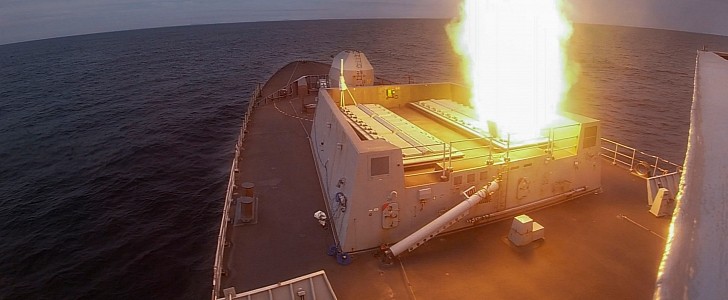Thanks to a £500 million ($680 million) upgrade, the Royal Navy's Type 45 destroyers are about to get more powerful than ever, as the main shield against air attack will be packed with missiles. And not just any missiles, but supersonic ones, as the six warships will add the Sea Ceptor to their arsenal.
Sea Ceptor is a ship-based air defense system designed to provide high levels of protection against a variety of threats. Its objective is to simultaneously counter and defeat several air targets. The next-generation Soft Vertical Launch (SVL) technology, which gives full 360-degree coverage, is what makes it so powerful.
This provides the Sea Ceptor a close-range capability. By comparison, Portsmouth-based vessels' existing Sea Viper system is smaller and has a shorter range, while Sea Ceptor can cover an area of 493 square miles (1,277 square kilometers).
Unlike Sea Viper, Sea Ceptor can engage multiple small surface targets at once and intercept them at speeds up to three times the speed of sound. The Sea Ceptor system will be installed on all six Type 45 destroyers, providing additional protection.
Moreover, the warships' primary weapon system and the first line of defense against air attacks will also be upgraded. While the Sea Ceptor is currently already used on all 13 Type 23 frigates and will be placed on their successor classes, the Type 26 and 31, the 45 destroyers are about to get the explosive technology as well.
Dubbed "the mushroom farm" because of the black caps on each missile launcher, the warships' silo (a space in which guided missiles are kept ready for firing) will house up to 24 Sea Ceptors. According to the Royal Navy, the first Sea Ceptor-enhanced Type 45 should be delivered by the summer of 2026, with the entire fleet being upgraded by 2032.
This provides the Sea Ceptor a close-range capability. By comparison, Portsmouth-based vessels' existing Sea Viper system is smaller and has a shorter range, while Sea Ceptor can cover an area of 493 square miles (1,277 square kilometers).
Unlike Sea Viper, Sea Ceptor can engage multiple small surface targets at once and intercept them at speeds up to three times the speed of sound. The Sea Ceptor system will be installed on all six Type 45 destroyers, providing additional protection.
Moreover, the warships' primary weapon system and the first line of defense against air attacks will also be upgraded. While the Sea Ceptor is currently already used on all 13 Type 23 frigates and will be placed on their successor classes, the Type 26 and 31, the 45 destroyers are about to get the explosive technology as well.
Dubbed "the mushroom farm" because of the black caps on each missile launcher, the warships' silo (a space in which guided missiles are kept ready for firing) will house up to 24 Sea Ceptors. According to the Royal Navy, the first Sea Ceptor-enhanced Type 45 should be delivered by the summer of 2026, with the entire fleet being upgraded by 2032.






